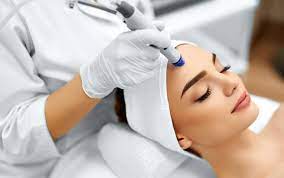Defining Beauty: A Closer Look at Non-Surgical Cosmetic Procedures
The pursuit of beauty has always been a part of human history, and in recent years, the field of cosmetic procedures has expanded to offer a wide range of options. Non-surgical cosmetic procedures have gained popularity as an alternative to invasive surgical procedures. These procedures provide individuals with the opportunity to enhance their appearance without the need for surgery or extensive downtime. In this article, we will explore non-surgical cosmetic procedures, examining their various types, benefits, safety considerations, and the impact they have on defining beauty in the modern era.
Types of Non-Surgical Cosmetic Procedures
Non-surgical cosmetic procedures encompass a broad range of treatments. Here are some popular options:
a) Dermal Fillers: Dermal fillers are injectable substances that restore volume to areas of the face, reducing the appearance of wrinkles, fine lines, and sagging skin. Hyaluronic acid fillers are commonly used to enhance facial contours and add youthful fullness. When considering dermal fillers, choose a reputable clinic, such as Contour Clinics Brisbane.
b) Botulinum Toxin (Botox): Botulinum toxin injections, commonly known as Botox, temporarily relax facial muscles, smoothing out wrinkles and lines. Botox is often used to treat forehead lines, crow’s feet, and frown lines.
c) Chemical Peels: Chemical peels involve applying a chemical solution to the skin to remove the outer layer, revealing smoother, rejuvenated skin. They can improve skin texture, reduce hyperpigmentation, and diminish the appearance of acne scars.
d) Laser Skin Resurfacing: Laser skin resurfacing uses laser technology to target specific skin concerns such as wrinkles, age spots, and scars. It stimulates collagen production, resulting in smoother, tighter skin.
Benefits of Non-Surgical Cosmetic Procedures
Non-surgical cosmetic procedures offer several benefits that have contributed to their popularity. Here are some key advantages:
a) Minimally Invasive: Unlike surgical procedures, non-surgical treatments are minimally invasive, involving less risk, minimal scarring, and shorter recovery times. They allow individuals to enhance their appearance with fewer risks and complications.
b) Quick Procedures: Many non-surgical treatments can be completed in a relatively short time, often during a lunch break or within an hour. This convenience appeals to those with busy lifestyles who seek immediate results without lengthy downtime.
c) Natural-Looking Results: Non-surgical procedures aim to enhance one’s natural features rather than altering them dramatically. Skilled practitioners can achieve subtle, natural-looking results that enhance facial harmony and rejuvenate the appearance.
d) Gradual Improvements: Non-surgical treatments often provide gradual improvements over time, allowing individuals to adjust to the changes and ensure they are satisfied with the results. This gradual approach can lead to more personalized and tailored outcomes.
Safety Considerations
While non-surgical cosmetic procedures are generally considered safe, it is crucial to consider certain factors before undergoing any treatment. Here are some safety considerations to keep in mind:
a) Qualified Practitioners: It is essential to choose a reputable practitioner who is experienced and qualified in performing non-surgical cosmetic procedures. They should have in-depth knowledge of facial anatomy, proper injection techniques, and follow stringent safety protocols.
b) Individual Assessment: Each person’s anatomy and aesthetic goals are unique. A thorough assessment should be conducted before any procedure to ensure the treatment is suitable and tailored to the individual’s needs.
c) Potential Risks and Side Effects: Although non-surgical procedures are generally safe, there can be potential risks and side effects. These may include bruising, swelling, infection, or allergic reactions. Understanding the potential risks and discussing them with the practitioner is important.
d) Post-Treatment Care: Following proper post-treatment care instructions is crucial for optimal results and minimizing complications. This may involve avoiding certain activities, using recommended skincare products, and attending follow-up appointments.
The Impact on Defining Beauty
Non-surgical cosmetic procedures have influenced the perception and definition of beauty in the modern era. Here’s how they have shaped beauty standards:
a) Age-Defying Approach: Non-surgical treatments offer individuals the opportunity to address signs of aging and maintain a youthful appearance. This has influenced the notion of beauty by challenging the traditional association of aging with diminished attractiveness.
b) Empowerment and Confidence: Enhancing one’s appearance through non-surgical procedures can boost self-esteem, empower individuals, and improve their overall confidence. This shift in self-perception can contribute to a broader definition of beauty based on self-acceptance and self-expression.
c) Emphasis on Individuality: Non-surgical procedures allow for personalized treatments that highlight and enhance an individual’s unique features. This emphasis on individuality challenges the idea of a one-size-fits-all standard of beauty and celebrates diversity.
d) Positive Body Image: Non-surgical procedures provide individuals with an opportunity to address specific concerns they may have about their appearance. By targeting these concerns, individuals can develop a positive body image and feel more comfortable in their own skin.
Conclusion
Non-surgical cosmetic procedures have become a significant aspect of the beauty industry, offering individuals the opportunity to enhance their appearance without undergoing invasive surgery. With a range of treatments available, individuals can address specific concerns and achieve natural-looking results. Non-surgical procedures provide several benefits, including minimal invasiveness, quick treatments, and gradual improvements. While considering these treatments, it is crucial to prioritize safety and choose qualified practitioners. These procedures have influenced beauty standards by challenging traditional notions of aging, emphasizing individuality, and promoting self-acceptance. By understanding the potential of non-surgical cosmetic procedures, individuals can make informed decisions about their aesthetic journey and contribute to defining beauty in the 21st century.
Read more: Pet Care in the 21st Century: Exploring Modern Kenneling Solutions

